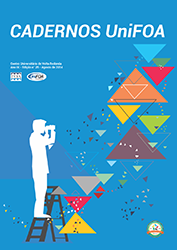Pensamento Matemático-Computacional
DOI:
https://doi.org/10.47385/cadunifoa.v15.n42.3035Palavras-chave:
Educação Matemática, Pensamento Matemático, Pensamento Computacional, Pensamento Matemático-ComputacionalResumo
Este artigo tem como objetivo construir uma teorização tendo como base os processos do Pensamento Matemático Avançado apresentados por Dreyfus (2002) e as concepções do Pensamento Computacional (2010). A metodologia utilizada foi a da pesquisa especulativa que são declarações teóricas de outras declarações. Concluiu-se com a apresentação do Pensamento Matemático-Computacional como uma teorização e algumas de suas características, como relação entre conceito e simbologia, representações concretas, inteirações e observação de padrões, ações que envolvem padrões, reflexões, diálogo e arguição, conexão entre os assuntos da disciplina, experienciação da evolução do pensamento científico, construção da notação e sistema de representações.
Downloads
Referências
COMITEE FOR THE WORSHOP ON COMPUTATIONAL THINKING; NATIONAL RESEARCH COUNCIL. Motivation — Why Should Anyone Care About Computational Thinking ?; Report of a Workshop on the Scope and Nature of Computational Thinking, Washington DC, 2010, p. 16 – 17.
DREYFUS, T. Advanced Mathematical Thinking. In: TALL, D. Advanced Mathematical Thinking; Kluwer Academic, New York, Dordecht, London, Moscow, 2002, p. 25 – 40.
HAREL, G; KAPUT, J; The Role of Conceptual Entities and their symbols in building Advancede Mathematical Concepts. In: TALL, D. Advanced Mathematical Thinking; Kluwer Academic, New York, Dordecht, London, Moscow, 2002, p. 82 – 93.
KHAN, K. Computational Thinking as the Automation of Abstractions. In: Comitee for the Worshop on Computational Thinking; National Research Council. Report of a Workshop on the Scope and Nature of Computational Thinking, National Academies Press, Washignton – DC, 2010, p. 16 – 17.
MARTINEAU, S.; SIMARD, D.; GAUTHIER, C. Recherches théoriques et spéculatives: considérations méthodologiques et épistémologiques. Recherches Qualitatives, Montreal, v. 22, n. 3, p. 32, 2001.
OLSON, D. R; CAMPBELL, R. N; Representation and Misrepresentation: On the Beginnings of Symbolization in Young Children. In: TIROSH, D; Implicit and Explicit Knowledge an Educational Approch, Ablex Publishing, New Yourk, 1994, p. 83 – 96. Acessado em: https://www.researchgate.net/publication/893482958 em 17/11/2016.
PLOT. B. Écrire une thèse ou un mémoire en sciences humaines. Paris. Librairie, Honoré Champion Éditeur, 1986.
VINNER, S; The Role of Definitions in The Teaching and Learning of Mathematics. In: TALL, D. Advanced Mathematical Thinking; Kluwer Academic, New York, Dordecht, London, Moscow, 2002, p. 65 – 79.
WING, J.M. Computational Thinking. In: Communications of the ACM. New York: vol 49, nº 3, march 2006, p 33 – 35.
WING, J. M. The Landscape of Computational Thinking. In: Comitee for the Worshop on Computational Thinking; National Research Council. Report of a Workshop on the Scope and Nature of Computational Thinking, National Academies Press, Washignton – DC, 2010, p. 8 – 10.
WING, J. M. Computational Thinking: What and Why. Disponível em: https://www.cs.cmu.edu/~CompThink/resources/TheLinkWing.pdf acesso em 10 out 2017.
Downloads
Publicado
Como Citar
Edição
Seção
Licença
Copyright (c) 2020 Cadernos UniFOA

Este trabalho está licenciado sob uma licença Creative Commons Attribution-NonCommercial-ShareAlike 4.0 International License.
Declaração de Transferência de Direitos Autorais - Cadernos UniFOA como autor(es) do artigo abaixo intitulado, declaro(amos) que em caso de aceitação do artigo por parte da Revista Cadernos UniFOA, concordo(amos) que os direitos autorais e ele referentes se tornarão propriedade exclusiva desta revista, vedada qualquer produção, total ou parcial, em qualquer outra parte ou meio de divulgação, impressa ou eletrônica, sem que a prévia e necessária autorização seja solicitada e, se obtida, farei(emos) constar o agradecimento à Revista Cadernos UniFOA, e os créditos correspondentes. Declaro(emos) também que este artigo é original na sua forma e conteúdo, não tendo sido publicado em outro periódico, completo ou em parte, e certifico(amos) que não se encontra sob análise em qualquer outro veículo de comunicação científica.
O AUTOR desde já está ciente e de acordo que:
- A obra não poderá ser comercializada e sua contribuição não gerará ônus para a FOA/UniFOA;
- A obra será disponibilizada em formato digital no sítio eletrônico do UniFOA para pesquisas e downloads de forma gratuita;
- Todo o conteúdo é de total responsabilidade dos autores na sua forma e originalidade;
- Todas as imagens utilizadas (fotos, ilustrações, vetores e etc.) devem possuir autorização para uso;
- Que a obra não se encontra sob a análise em qualquer outro veículo de comunicação científica, caso contrário o Autor deverá justificar a submissão à Editora da FOA, que analisará o pedido, podendo ser autorizado ou não.
O AUTOR está ciente e de acordo que tem por obrigação solicitar a autorização expressa dos coautores da obra/artigo, bem como dos professores orientadores antes da submissão do mesmo, se obrigando inclusive a mencioná-los no corpo da obra, sob pena de responder exclusivamente pelos danos causados.










